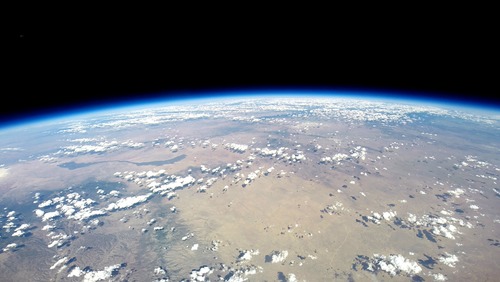
A view of the Earth taken from an altitude of 36 kilometers (120,000 feet) on a World View test flight June 18. The company plans to use that balloon to fly research payloads later this year. (credit: World View)
World View Enterprises, the company developing a commercial high-altitude balloon system to provide a flight experience like some aspects of spaceflight, has selected an initial group of research payloads that will fly on one of the company’s balloons as soon as this year, as the firm diversifies beyond tourism.
The three experiments, announced in a company press release July 28, are a radiation measurement experiment by Space Environment Technologies, a meteor imager from the SETI Institute, and a student-built ozone monitor from the Florida Space Grant Consortium. The three are slated to fly in late 2014, according to the company.
“In the research and education world, we think we offer something really special,” said Alan Stern, a founder of World View and the company’s chief scientist, in a speech at the NewSpace 2014 conference in San Jose, California, on July 26. Experiments can be automated or, in later crewed versions of World View’s balloon, human-tended. “We can let researchers operate the same way that they do in a university of industrial lab, removing the need for automation.”
These three experiments will fly on the Tycho-800 balloon, which the company flew on its first test flight in mid-June. At that time, World View chief technology officer Taber MacCallum said the company had gotten early interest in using that balloon for technology demonstration and other research. “It looks like that, early on, we could be in the business of doing experiments and test flights,†he said at the time.
Stern said in his NewSpace speech that the company has also seen interest in using the balloons as commercial platforms beyond research and tourism. “In addition, there’s a very large interest that we’re seeing in something called ‘stratollites,'” which he defined as high-altitude balloons performing missions traditionally done by satellites, but at much lower costs. These applications could include both remote sensing and communications; in the latter case, companies like Facebook and Google have expressed interest in stratospheric platforms (balloons and UAVs) as a means of providing Internet access.
“The interesting thing from our perspective, starting this off as a company with an interest only in research and education and tourist markets, how often we find other businesses and government agencies knocking on our door” to see how they could use a balloon platform like World View, Stern said. “We think of the stratosphere as a greenfield, ready for development with the technology of the 21st century.”
World View, though, is still planning to fly tourists, with those flights slated to begin in late 2016. “It’s going to be a tremendous experience,” Stern said of those flights, which will carry six people and two crew into the stratosphere with amenities not found in spacecraft. “This is the only spaceship that I know of that’s got a bar.”

I have a hard time calling it a spaceship. Useful? Sure. Impressive? Yeah. Innovative? You betcha. Disruptive? Definitely.
… but not a spaceship.
Not a pure spaceship, certainly, but I’d be inclined to grant partial credit. It will apparently fly roughly 36% of the way to the Von Karman Line. In terms of the Earth’s atmosphere, it will fly above 99% or more of it. Not space, but certainly “space-adjacent.”